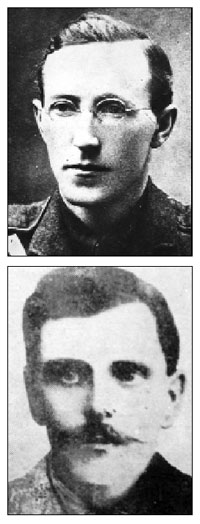3 September 2009 Edition
Remembering the Past: The Fermoy ambush and British reprisals

Liam Lynch and Michael Fitzgerald
BY MÍCHEÁL Mac DONNCHA
BY the autumn of 1919, the Irish people and British forces in Ireland were set on a path of armed conflict that was about to escalate significantly.
The British Government had refused to recognise Dáil Éireann and had imposed a system of military rule. On 20 August, the Dáil agreed an oath to the Irish Republic to be taken by all its members and by all IRA Volunteers.
The first major action after this significant development and the first concerted attack on the British Army since 1916 was in the town of Fermoy, County Cork. It was led by Liam Lynch, Officer Commanding, Cork No 2 Brigade, IRA. The aim of the ambush, as with most such operations in 1919, was to capture badly-needed weapons. The decision to mount the attack was a daring one given the overwhelming numbers of British forces in the garrison town of Fermoy and the fact that the Volunteers were armed only with revolvers. IRA GHQ had authorised the operation on condition that Lynch would disarm British soldiers without causing casualties.
MARCHING TO CHURCH
An armed detachment of British soldiers marched each Sunday from their barracks to the Wesleyan church in Fermoy. On 7 September 1919, there were 15 soldiers in the detachment and waiting for them were some 25 members of the local IRA company. They had only six revolvers between them and were stationed in groups of two and three in the vicinity of the church. Two cars were ready to take the captured rifles away, the first near the church and the second following the military detachment.
When the British soldiers reached the church they were overtaken by the second car carrying Liam Lynch. He called on them to surrender. They refused and there was a confused struggle between the soldiers and the IRA Volunteers. One British soldier was killed and three were wounded. The captured 15 rifles were taken away in the cars and outside the town trees were felled in their wake to prevent pursuit by British vehicles.
Within hours of the ambush, the British Army began intensive raids and searches in the surrounding countryside.
The following night, soldiers from the barracks invaded the town and smashed up and looted shops in the main streets of Fermoy.
Two nights later, they appeared for a repeat performance but were forced back to barracks when they were attacked by townspeople armed with sticks and stones.
The Fermoy reprisals were the first such revenge raids by the British Army and many worse were to follow once the Black and Tans and Auxiliaries were introduced.
ITGWU
One of the participants in the Fermoy ambush was Michael Fitzgerald, O/C of the First Battalion, Cork No 2 Brigade, and secretary of the Fermoy branch of the ITGWU.
Arrested after the Fermoy action, he was held in Cork Jail where he embarked on hunger strike. He died on the fast on 17 October 1920, followed within days by his fellow prisoner in Cork, Joseph Murphy, and by Cork Lord Mayor Terence MacSwiney in London.
The Fermoy ambush took place 90 years ago, on 7 September 1919.


